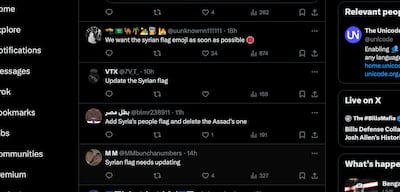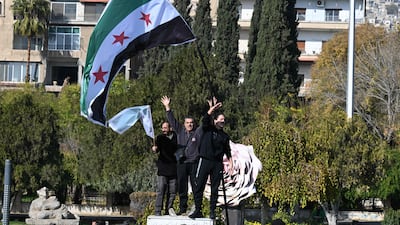Live updates: Follow the latest on Syria
It may already have been flown at the Syrian embassy in Moscow, but the opposition flag that has become prominent in the news since rebels seized power in Syria may not be available on cell phones as an emoji anytime soon.
Bashar Al Assad’s fall from power has sparked celebrations among millions of Syrians, with many taking to the streets with the opposition flag, which features three stars and green, white and black stripes.
This has led to calls for the flag, first used in the 1940s after independence from France, to officially replace the country's current banner, which was adopted in 1980 under Bashar Al Assad's father, Hafez.
Online, many Syrians around the world have also said they want the flag to be available as an emoji on their phones. Unicode Consortium is the authority tasked with standardising emoji codes and digital characters across billions of smartphones and mobile devices globally.
On social media platform X, Unicode's account has been flooded with calls to update the Syrian flag emoji. Many users have been replying even to non-Syria social media posts, asking the Consortium to make the changes quickly.
But Unicode has told The National that the design and colours of emojis are up to smartphone and mobile device manufacturers, not Unicode.

“All of the colourful emoji images found on various devices are supplied and distributed by vendors for their products. Any concerns or comments should be directed to the manufacturer of your device,” Unicode told The National in an email.
One of those device makers, Apple, has also seen requests regarding the Syrian flag on the company's community support message board.
"I hope Apple updates it to the correct version as soon as possible, the right one is attached in photo," wrote a user, showing the depiction of the three star flag requested.
The National has reached out to Apple for comment regarding the flag, but has not yet heard back.
Unicode referred The National to a blog post from 2022 titled The Past and Present of the Flag Emoji, in which the consortium announced that it would no longer be accepting flag emoji submissions.
“The inclusion of new flags will always continue to emphasise the exclusion of others,” the blog entry reads in part.
“And there isn’t much room for the fluid nature of politics – countries change but Unicode additions are forever – once a character is added it can never be removed.
“We realise closing this door may come as a disappointment – after all, flags often serve as a rallying cry to be seen, heard, recognised, and understood,” Unicode added, while also pointing out that “font designers can always update the designs as regimes change.”

Unicode also stated that despite being the largest emoji category, flags are some of the least used emojis, with a few exceptions such as the rainbow flag.
In turn, Unicode said that it can be cumbersome and time consuming to encode more flag standards across the board.
Several years before Unicode's 2022 flag emoji freeze announcement, Nato tried unsuccessfully to convince the consortium to lay the groundwork for the political and military alliance to have its own flag emoji.
A few years later, in connection with its 70th anniversary, the defence bloc promoted a petition effort that also failed to convince the Unicode to add a Nato flag.
The Unicode Consortium does occasionally add new emojis based on ideas submitted to its emoji subcommittee, but the onus is on the idea submitter to prove there's justification for the new design.
Those who submit are often required to prove that their emoji idea breaks new ground, isn't overly specific, and also provide data to help justify the need for a new emoji.
“More weight is given to emoji that convey concepts that are not simply variants of concepts conveyed by existing emoji or sequences of existing emoji,” reads one of the many guideline notes for submitting an proposal to Unicode.
Ultimately, how the emojis look is up to operating system, smartphone and device makers.
For example, emojis on iPhones look slightly different compared to how emojis appear on Android devices, although there's still parity in terms of recognition.
While Unicode's policy states that no new flag emojis will be accepted, in the case of the existing flag design for Syria, a new emoji submission may not be required in the first place if the manufacturers take matters into their own hands.
The current Syrian flag features horizontal stripes of red, white, and black from top to bottom, common colours to represent Arab unity. Two green stars adorn the middle white section, representing Egypt and Syria as the founding nations of the short-lived United Arab Republic formed after the end of European colonialism.
It was first designed in 1958, but the flag was modified several times before its adoption in the 1980s.
The flag used by Syria's rebels and considered likely to be adopted in the country's near future contains the same colours in a different order. Instead, it has a tricolour of horizontal stripes of green, white and black with three red stars in the middle and its origins are even older than that of two-star version. It was Syria's official flag in 1946 when the country gained independence from France and was once enshrined in the country's constitution.
It has been slung around the shoulders of Syrians celebrating their freedom and hung on the doors of embassies around the world.

